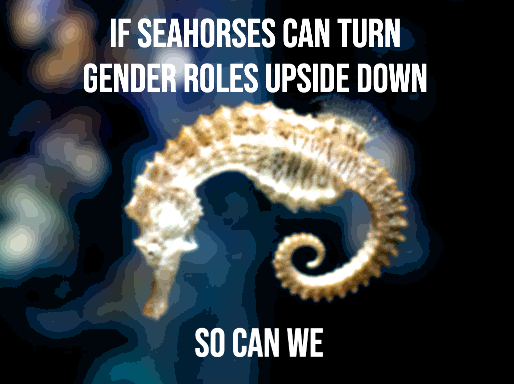Seahorses and gender roles in the natural world

“It is the role of a woman to nurture and raise the children while the man goes out and makes money.”
“How you’re born is what you are: there is no changing that and there is definitely no in-between.”
Both of these comments are used to hold people to a system of norms, an enforced list of ways people are supposed to act based on their genitalia. These norms and roles are justified by the concept of what is “natural,” but it is important to examine what “natural” really means. There is nothing more natural than animals in their own habitats. If you observe these animals, you will find they don’t adhere to what humans consider the norm and in fact completely flip human gender roles on their heads.
Seahorses (Hippocampus kuda): Seahorses are found in a lot of different areas, but always in salt water. They are a fish and tend to live anywhere from three to five years. Though seashores are known for their unusual look, it is also well-known that seahorses are one of the only species where males are the ones who grow and give birth to their young. According to a scientific study by Qin et. al, published by Geomics, “Females transfer large, yolk-rich eggs into the specialized brooding structure (brood pouch), which the males immediately fertilize, and the male incubates developing embryos in the brood pouch where embryos are aerated, osmoregulated, protected and likely provisioned during their development.”
That is just a complicated way of saying that the females produce the eggs and then transfer them to the male’s care. The male then fertilizes and nurtures them until they are ready to go off on their own, completely flipping the traditional human gender roles, making it so the only nurturing the young seahorses will get is from their father. The concept of male pregnancy is a novel idea, but the flipping of human created gender roles happens all over in aquatic life.
Clownfish (Amphiprioninae): Clownfish live in anemones and will live six to ten years. They will also make a complete male to female transition. According to scientific study called “Sex Change in Clownfish: Molecular Insights From Transcriptome” by Casas et. al, “The male is poised to become female and rapidly changes sex to assume the vacated position, while the largest undifferentiated fish completes the breeding pair by turning into a mature male in a short time.” The authors continue, saying, “This ability allows the formation of a new breeding pair, preventing the need for dangerous travel across the reef, but requires the presence of subdominant fish to complete the sex change.”
In simple terms, in their social assemblies (what we would call families), there is a dominant female. If that female dies, a male will make a full transition into a female, first taking on a mental change which is followed by a physical transition into a female, allowing the assembly to continue with the production of new members. Also notable is that clownfish will be born with both male and female sex organs. The male one matures and the female one matures only if there is a need within the assembly.
Hermaphrodite species (earthworms, barnacles, snails, slugs, etc): These are species of note because they are what we would refer to as intersex or nonbinary. Every member of the species has both sex organs and can reproduce with any mature member of their species, giving us an example of an animal in their natural environment not using gender roles period and not caring who they are with.
Animal instincts are natural, yet there are a lot of examples of them not following what humans would consider “natural.” The animal kingdom shows us that the use of “it’s not natural” as an argument to counter ideas about gender is rooted in intolerance and has no foundation in reality.




Mitchell • Feb 22, 2022 at 1:30 pm
like the detail and amount of information provided